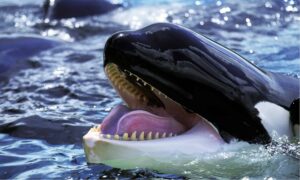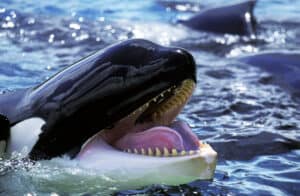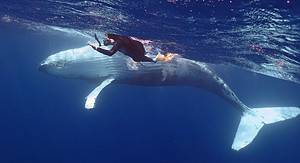Welcome to our article on the diverse array of whales in Florida. From majestic humpbacks to elusive orcas, we invite you to embark on a thrilling journey. Dive through the deep blue waters as we explore the mesmerizing world of these creatures.
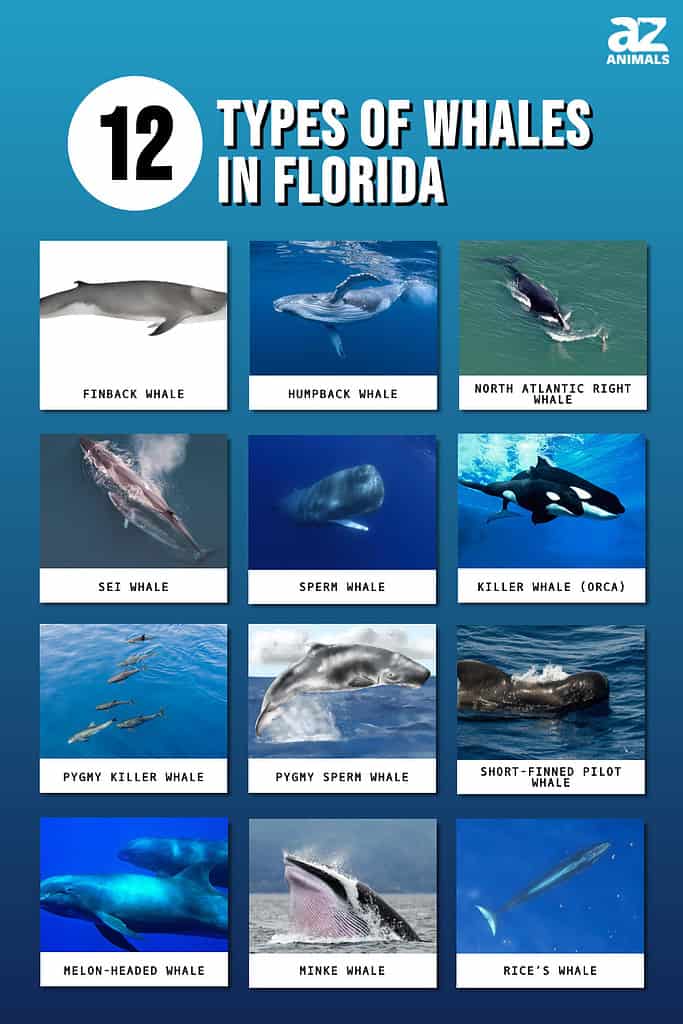
Where To See Whales in Florida
Florida is a great destination for whale-watching, with plenty of opportunities to get up close and personal with these magnificent mammals. The northeastern shore of the state is the best spot to see whales. If you visit anywhere between Cape Canaveral and Jacksonville, you are sure to see a whale! Whether you’re looking for a day trip or a longer excursion, here are some of the best places to go whale-watching in Florida.
- Fernandina Beach: This location offers an excellent chance to spot whales. Visitors can also enjoy the park’s other wildlife, such as sea turtles, bottlenose dolphins, and sea birds.
- Key West: The waters around the Florida Keys are home to a variety of whale species, including the humpback whale, Bryde’s whale, and sperm whale. Boats leave from Key West for whale-watching tours throughout the year.
- St. Augustine: This is a great place to spot whales in the spring and summer. There are plenty of whale-watching tours available, and visitors can also enjoy the area’s other attractions, such as white sand beaches and water sports.
- Canaveral National Seashore: This seashore is located on the east coast of Florida and provides visitors with a great opportunity to spot whales. Visitors can also enjoy the seashore’s other wildlife, such as sea turtles, dolphins, and manatees.
No matter which spot you choose, whale-watching in Florida is an unforgettable experience. Get ready to spot some of the world’s largest mammals in their natural habitats.
Best Time To See Whales in Florida
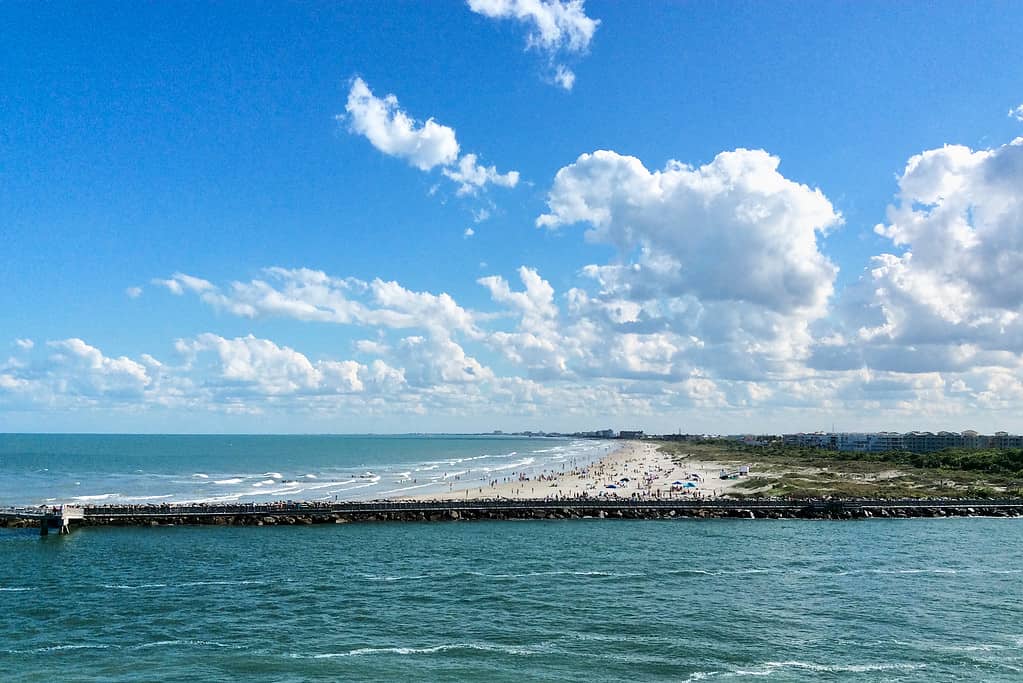
The northeastern side of Florida is an epic place for whale-watching in the winter months.
©iStock.com/Martseniuk
Seeing whales near the shore in Florida can be a thrilling experience. Whales are magnificent creatures, and the opportunity to witness them up close is something special. The best time to see whales in Florida is during the winter and early spring months. During this time, whales migrate to warm waters near the state to give birth. This migration period typically begins in December and lasts through March, making these months the ideal time to spot them.
In addition to the winter months, the late spring and summer months can also provide great opportunities for whale sightings. Whales typically make their way back to the northern regions in April and May, so this is a great time to look for them. The summer months are also a good time for spotting whales, as they stay in the nearby waters to feed and rest.
12 Types of Whales in Florida
Florida waters are home to several species of whales, including Humpback Whales, Fin Whales, and Pilot Whales. Some of the whales near the Florida coast have special protections. Read on to find out more.
1. Finback Whale
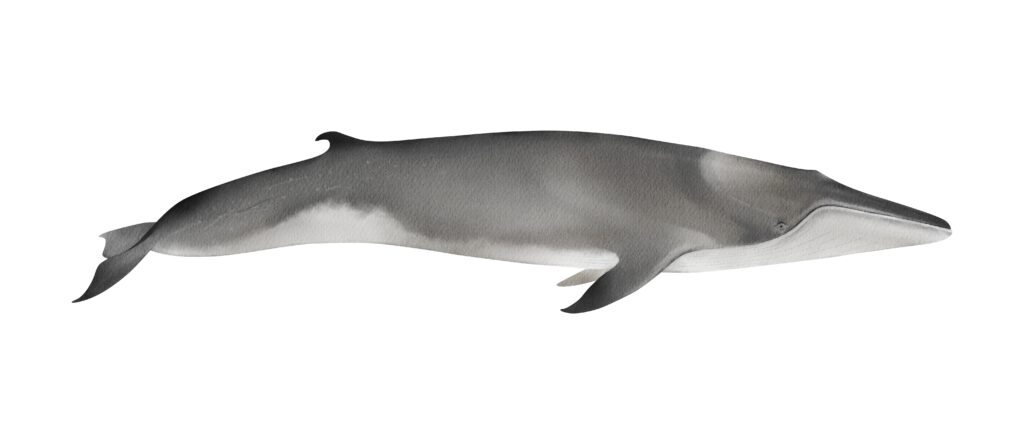
One of the whales in Florida is the finback whale.
©Diana Askarova/Shutterstock.com
The finback whale is an impressive creature, measuring up to 88 feet in length and weighing up to 79 tons. Its long, slender body is a grey color on its upper side and white on its underside. Its dorsal fin is curved and long, and its flippers are broad and paddle-shaped.
Finback whales are classified as endangered species, with fewer than 10,000 left in the wild. We still need conservation efforts such as creating protected areas and increasing public awareness to ensure their survival.
Finback whales feed mainly on krill, small schooling fish, and squid. They consume up to 2.5 tons of food each day, using their baleen plates to filter out their prey from the ocean water. As they feed, they use a combination of echolocation and vision to locate and capture their food.
2. Humpback Whale
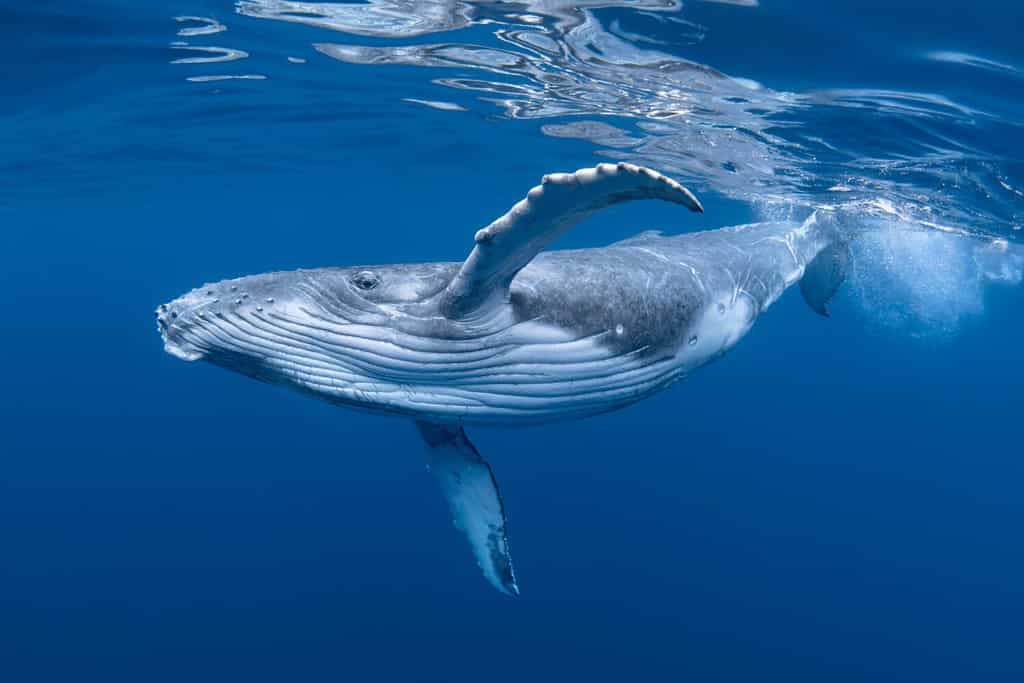
Believe it or not, this gigantic whale is a baby!
©Craig Lambert Photography/Shutterstock.com
The majestic humpback whale is a large species of cetacean that can grow up to 60 feet in length and weigh up to 40 tons. They have distinctive bumpy heads, long pectoral fins, and a tail that is shaped like a scythe. Their coloring is usually dark grey on top and white on the underside.
Humpback whales are listed as a “Least Concern” species by the International Union for Conservation of Nature, meaning they are not currently threatened with extinction. Despite this, they are still vulnerable to human activity, such as overfishing and ocean pollution.
Humpback whales typically feed on krill, small fish, and plankton. They are very vocal and have a wide range of vocalizations that they use to communicate with one another.
3. North Atlantic Right Whale
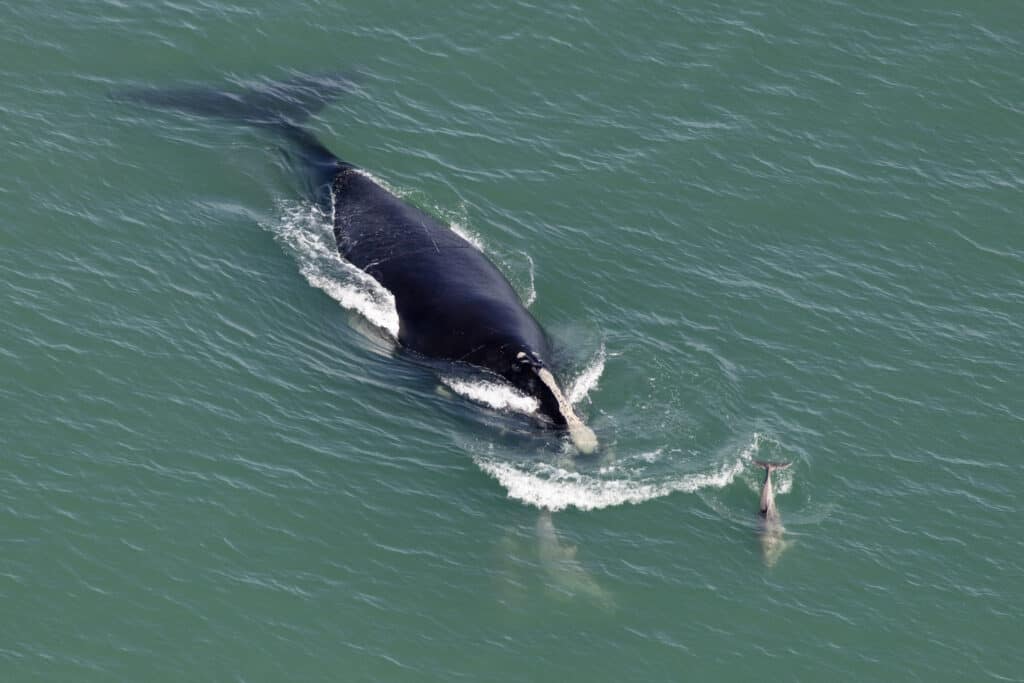
This is a special whale in Florida and is a protected species. They swim close to the surface, so boaters beware.
©iStock.com/6381380
The North Atlantic Right Whale is an impressive species, with an average length of around 50 feet and weighing up to 70 tons. They have dark grey heads and backs and a light whitish coloring on their bellies and sides. They have a unique V-shaped blowhole and a distinctive jagged upper jawline.
Unfortunately, their population numbers have dwindled drastically due to whaling and other human impacts. They are now listed as an endangered species and are protected under the US Endangered Species Act.
Their diet consists mainly of small fish, krill, and plankton, and they prefer to feed in shallow waters.
In order to help protect this species, boaters should follow guidelines such as staying at least 500 yards away from them, avoiding sudden speed changes, and refraining from any loud noises.
4. Sei Whale
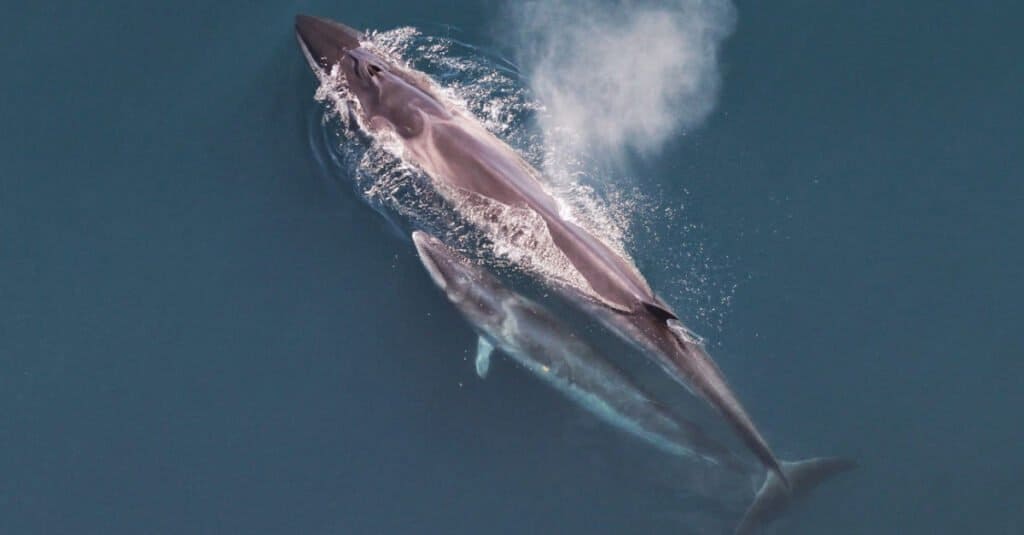
The beautiful sei whale comes close to the shores of Florida to have her baby.
©Christin Khan, NOAA / NEFSC, Public domain, via Wikimedia Commons – License
The sei whale (Balaenoptera borealis) is a large, slender baleen whale found in all major oceans. They grow up to 50 feet in length and can weigh up to 50 tons. The sei whale’s upper body is a dark blue-gray color, while its underside is lighter in color. Its distinctive dorsal fin is small and curved with a pointed tip.
The sei whale is currently listed as endangered by the International Union for Conservation of Nature. This is largely due to the commercial whaling which took place in the 20th century, and the sei whale is still vulnerable to being hunted in some countries.
The sei whale feeds mainly on krill, small fish, and other zooplankton. Scientists believe that they travel long distances for food and can cover thousands of miles in a single migration.
5. Sperm Whale
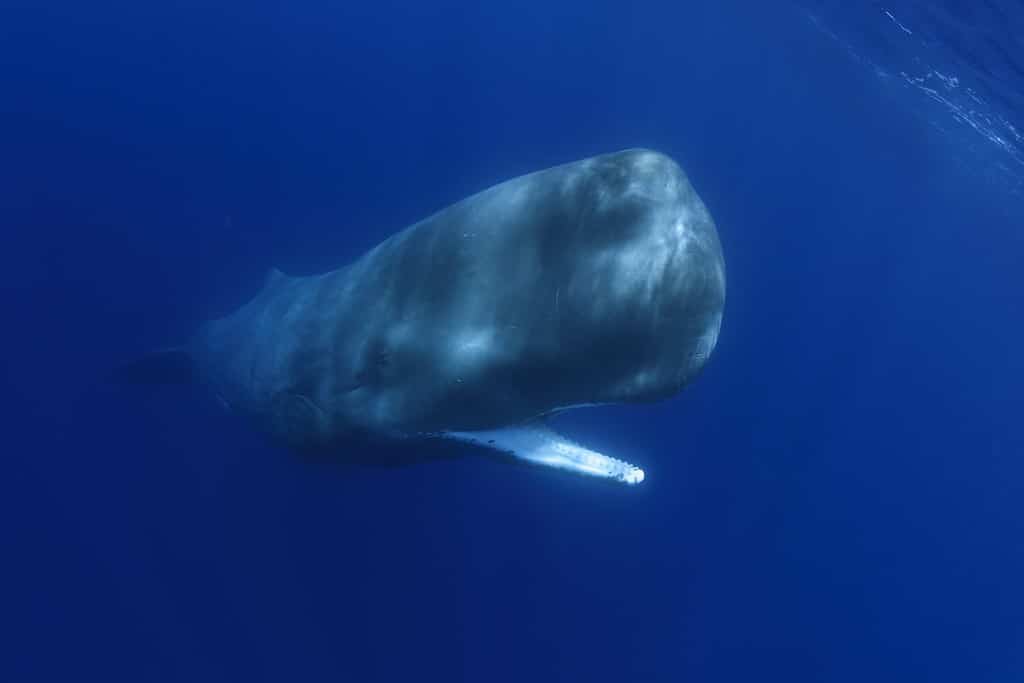
If you want to see whales in Florida, keep your eyes peeled for a sperm whale.
©Thierry Eidenweil/Shutterstock.com
The sperm whale is a large-toothed whale that is typically dark grey or brownish in color. It has an enormous square head and a short, thick body. The sperm whale also has a series of ridges that run along its back. It can grow to be as long as sixty feet and weigh up to fifty tons.
The sperm whale is listed as vulnerable by the International Union for Conservation of Nature. They are threatened by human activities such as hunting and entanglement in fishing gear.
The sperm whale’s diet consists mainly of squid, though they also eat fish and octopuses. They like to dive to depths of over 3,000 feet in search of food.
Sperm whales are migratory animals, traveling in pods of up to twenty individuals. They migrate between the equator and the poles, depending on the season and availability of food.
6. Killer Whale (Orca)
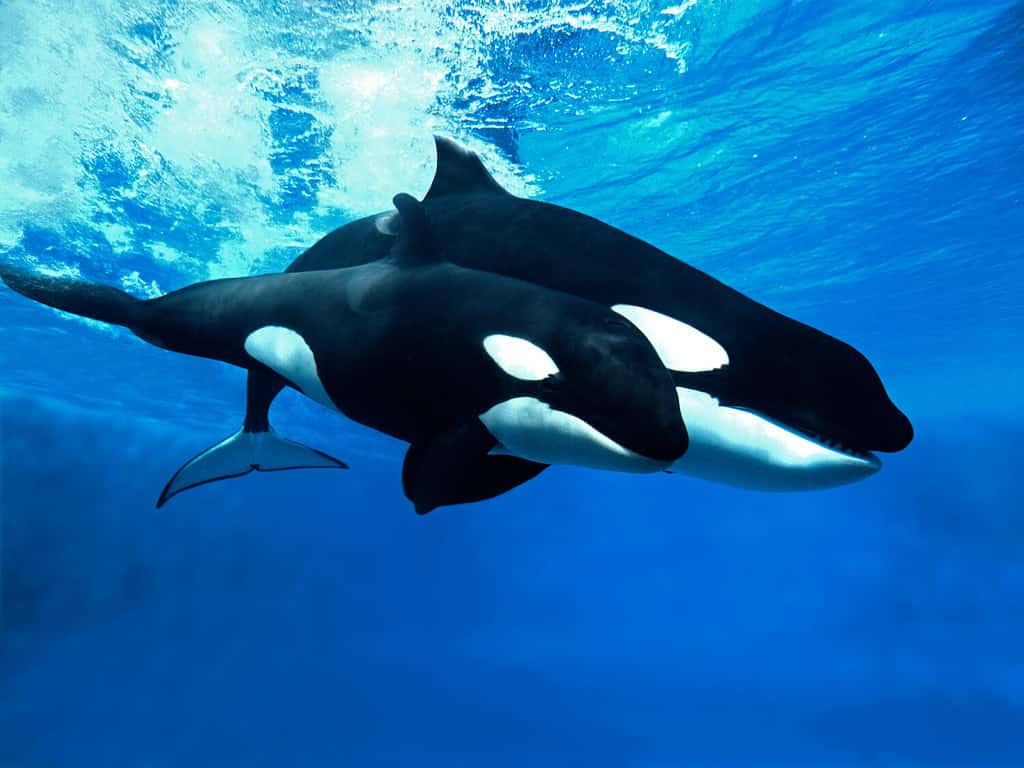
Orcas are another species of whale in Florida that has babies in the warm waters near the shoreline.
©slowmotiongli/Shutterstock.com
Killer whales, also known as orcas, are large marine mammals belonging to the oceanic dolphin family. They are recognizable by their distinctive black-and-white coloring and tall, pointed dorsal fin. On average, adult males grow to a length of 26-30 feet and weigh up to 6 tons. Females are typically smaller, reaching a maximum size of 19-23 feet and weighing up to 3 tons.
Killer whales are currently listed as a species of “Least Concern” on the IUCN Red List, meaning they are not currently considered to be at risk of extinction. They have a varied diet, including fish, squid, and marine mammals such as seals and dolphins. Killer whales are highly social and typically travel in pods of up to 40 individuals, sometimes migrating over long distances.
7. Pygmy Killer Whale (Oceanic Dolphin)
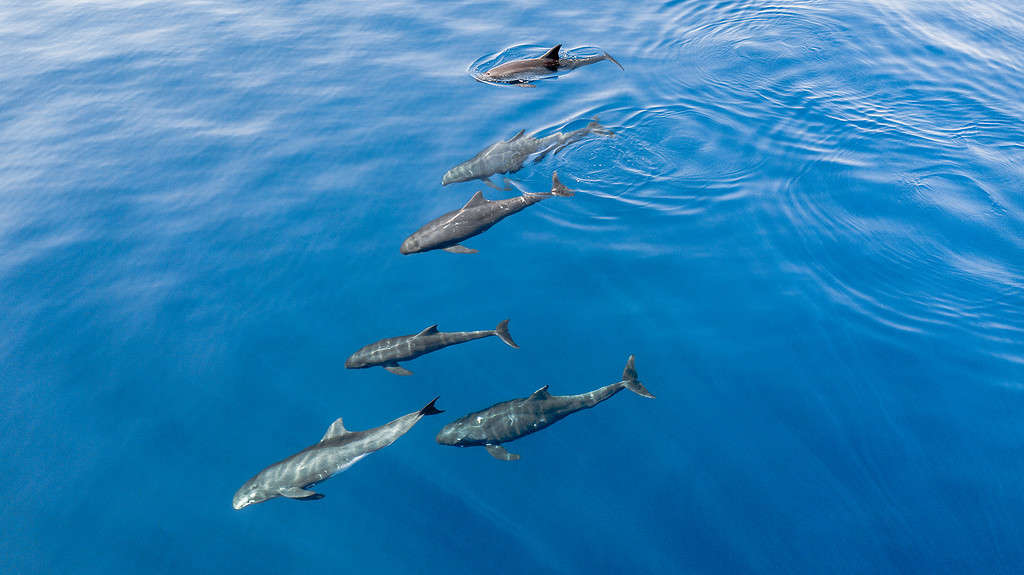
Actually, an oceanic dolphin, the pygmy killer whale, swims in the warm waters of Florida in December.
©Marcelo Johan Ogata/Shutterstock.com
The pygmy killer whale is a small species of dolphin that you can recognize by its dark grey or black body and white markings on the underside. This species is the smallest of all oceanic dolphins, reaching an average length of 6.6 feet and a maximum length of 8.2 feet. They possess a round head, a small, curved dorsal fin, and a short beak that tapers off towards the end.
The pygmy killer whale has been classified as a “least concern” species by the IUCN Red List, meaning their population trends are stable. There are some threats to this species, including entanglement in fishing gear, pollution, and potential habitat destruction.
Pygmy killer whales feed primarily on fish, cephalopods, and crustaceans. They hunt individually or in small groups and usually forage in deeper waters.
Pygmy killer whales are migratory and live in tropical and subtropical waters, although people have observed them in temperate waters as well. They typically migrate to higher latitudes during the summer and move to lower latitudes during the winter.
8. Pygmy Sperm Whale
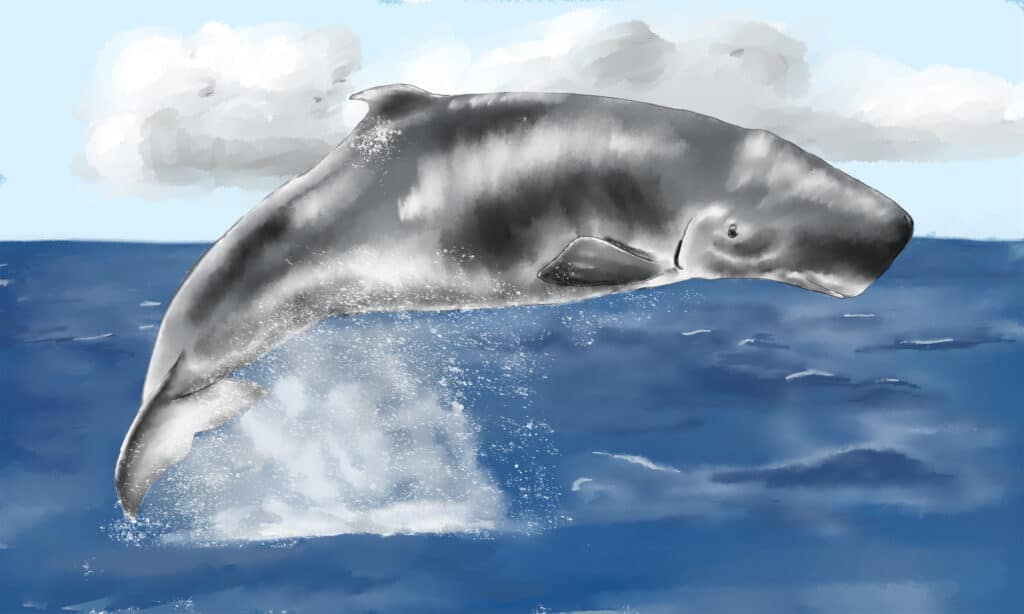
The pygmy sperm whale is a species of toothed whale that is part of the cetacean family. They measure between eight and nine feet long and weigh between 1000 and 1500 pounds. The pygmy sperm whale has a pale gray or brown body with a counter-shaded white underside. They have a short, stubby beak and a low, rounded forehead.
The conservation status of the pygmy sperm whale is currently classified as “Least Concern” by the International Union for Conservation of Nature (IUCN). However, their population numbers are declining due to commercial fishing and habitat loss.
Their diet consists mainly of squid, cuttlefish, and small fish. Pygmy sperm whales hunt for food by diving deep into the ocean. These whales migrate long distances, and people have spotted them in areas throughout the Pacific and Atlantic oceans. They typically travel in small groups of 2-10 individuals.
9. Short-Finned Pilot Whale
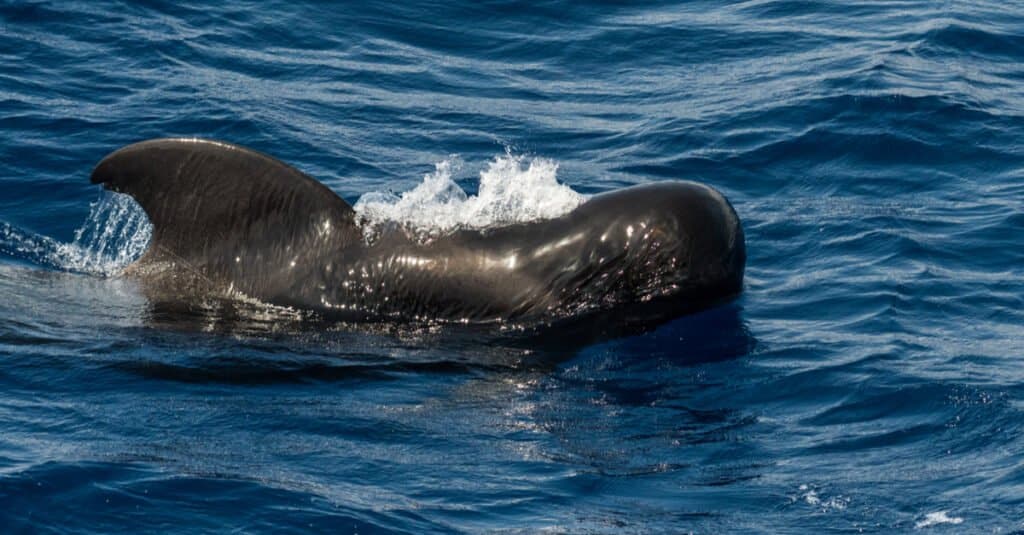
Some short-finned pilot whales have light-colored patches on their dorsal fins.
©Marcos del Mazo/Shutterstock.com
The short-finned pilot whale is a species of oceanic dolphin that lives in tropical and temperate waters around the world. They are typically black or dark gray and have a bulbous head, short beak, and a curved dorsal fin. Adults can grow up to 18 feet long and weigh up to 5,000 pounds.
The short-finned pilot whale is classified as “Near Threatened” on the IUCN Red List, largely due to the threats posed by entanglement in fishing gear and noise pollution from human activities.
The short-finned pilot whale mainly feeds on squid and other small fish. These whales are highly migratory, traveling thousands of miles each year between their breeding grounds and feeding areas.
10. Melon-Headed Whale
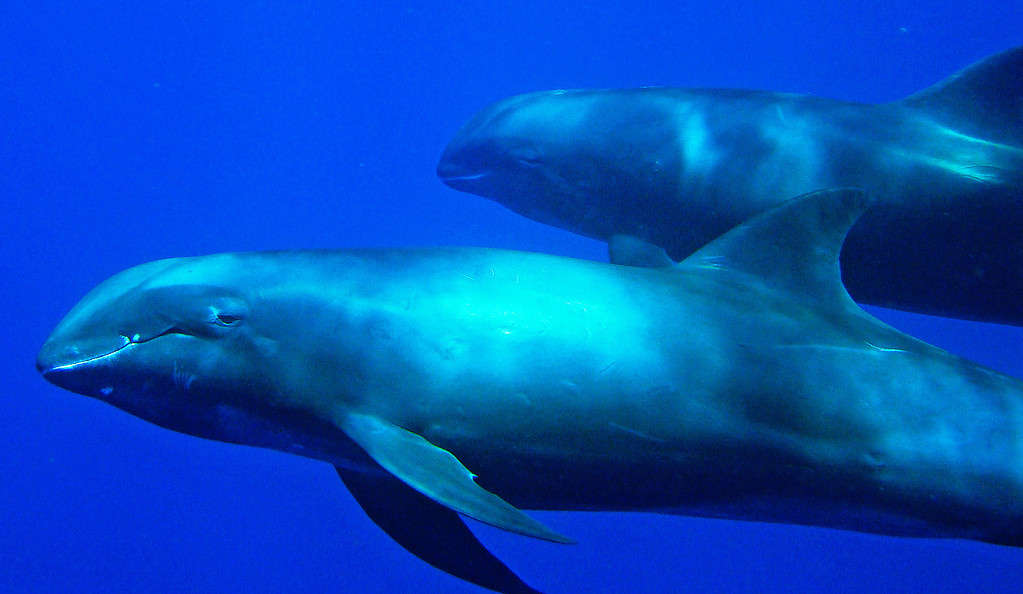
You can occasionally spot a melon-headed whale in Florida.
©USFWS – Pacific Region, Public domain, via Wikimedia Commons – License
The melon-headed whale is a species of small-toothed whale and is a member of the Delphinidae family. It has a round head and a slender body and is usually grey or black in color. It can reach lengths of up to 8-9 feet and weigh up to 440-500 pounds.
The melon-headed whale is listed as Vulnerable on the IUCN Red List, primarily due to their low population numbers and the threat of bycatch in fishing nets.
The melon-headed whale feeds mainly on squid and small fish. They migrate seasonally, often traveling to the warm waters of Florida in the winter months. They also gather in large groups for feeding and breeding.
11. Minke Whales

The minke whale has an incredibly large range!
©Annie Leblanc/Shutterstock.com
The Minke whale is a small baleen whale that can grow up to 32 feet in length and weigh up to 10 tons. That is 20,000 pounds! They have a distinctive white band on their flippers and a white chevron on their back. People often mistake them for fin whales due to their similar size and shape.
The Minke whale is classified as “Least Concern” in terms of conservation status by the International Union for Conservation of Nature. They live in all oceans and feed on krill, fish, and squid. You can see these whales in Florida in the summer months.
12. Rice’s Whale
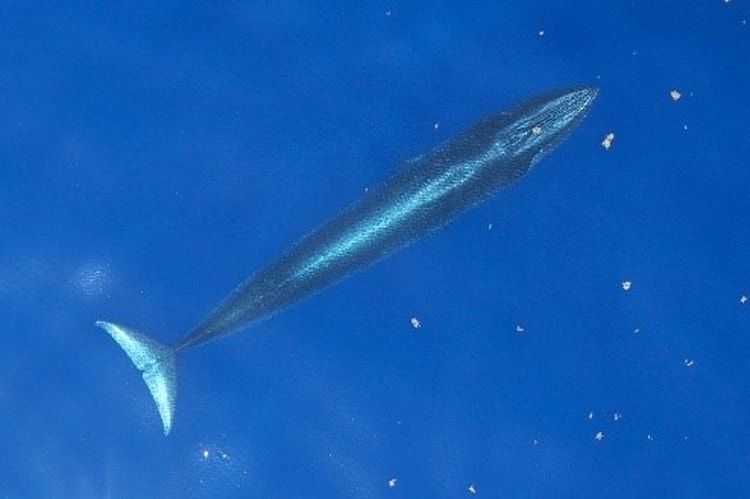
There are less than 100 Rice’s whales left in the world.
©National Oceanic and Atmospheric Association (NOAA), Public domain, via Wikimedia Commons – License
The Rice’s whale (Balaenoptera ricei) is a species of baleen whale that lives in the northeastern Gulf of Mexico, near Florida. It is one of the smallest species of baleen whale, measuring up to 24 feet in length and weighing up to 4.5 tons (9,000 pounds).
The Rice’s whale is listed as critically endangered by the IUCN Red List due to its small population size. Scientists believe that there are only around 50-100 individuals in existence.
The Rice’s whale feeds primarily on small crustaceans, such as copepods and krill, and sometimes on small schooling fish. This whale is a migratory species, moving north in the summer and south in the winter in search of food.
The photo featured at the top of this post is © Justin Berken/Shutterstock.com
Thank you for reading! Have some feedback for us? Contact the AZ Animals editorial team.




